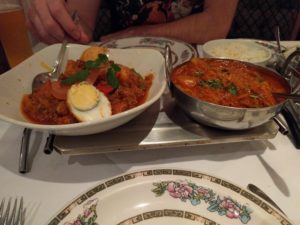I’ve always enjoyed The Raj Pavilion in Brighton. It’s your regular British-Indian restaurant and a curry-loving friend lived close by. I was recently hiking with this same friend in Kent, and we found ourselves at a different restaurant called the Raj Pavilion. While both restaurants included the many of the same dishes on the menu, they had few other connections – including the recipes used for the dishes.
One of the fascinating things about British curry houses (which is also true of Chinese food) is that nobody has ever established a large chain. In fact, the largest curry restaurant in the UK is Wetherspoons, whose Wednesday Curry Club serves more Indian meals than any other organisation. Despite this, there are many similarities between different restaurants. After the second world war, many people worked for the Bahadur brothers and were then encouraged to open their own restaurants. This led to places serving the same dishes across the UK. Another things that recurs are the names.
The first curry restaurant in the UK was the Hindoostanee Coffee House, opened by Sake Dean Mahomed in 1810. In the early 20th century restaurants such as Salut e Hind and The Shafi were opened. Veeraswamy, the oldest surviving Indian restaurant, was opened in 1926 and given the owner’s family name – Edward Palmer had an Indian Princess for a grandmother. Bir Bahadur opened the Kohinoor in London. A series of other Bahadur restaurants followed, including Taj Mahals in Brighton, Northampton and Oxford, and Kohinoors in Cambridge and Manchester.
In her recent article Who Killed the British Curry House, Bee Wilson talked about the changing fashion in curry house names:
You can judge the age of a British curry restaurant from its name. If you see one that is called Taj Mahal, Passage to India or Koh-i-Noor (after the famous Indian diamond), it probably dates back to the first wave of curry houses in the 1960s… The names of 1970s curry houses began to shrug off the colonial past and evoke, instead, a vague sense of eastern exoticism: Lily Tandoori, Aladdin, Sheba – glamorous names to counteract longstanding British prejudices that south Asian food was malodorous and unclean. By the 1980s, however, such orientalism had also begun to seem hackneyed, and new restaurants opening in that decade often named themselves after ingredients, a more subtle form of rebranding: Tamarind, Cumin, or Lasan (Hindi for garlic).
A 2014 survey took place of the most common restaurant names in the UK. The top ten curry house names were:
- Saffron (54)
- Taj Mahal (48)
- Taste of India (48)
- Bengal Spice (40)
- Spice of India (40)
- Little India (30)
- Spice of Life (27)
- The Raj (26)
- Eastern Spice (23)
- Bombay Spice (21)
How many of these have you eaten at?

Was any food ever so thoughtfully designed to please its audience as the early curry house menus?